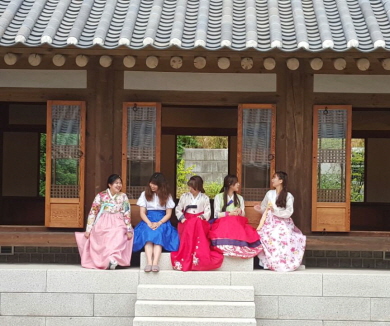
The one and only hanbok student club at Ewha, Hedereojida aims to break the stereotype that hanbok is a traditional clothing only worn on special occasions or holidays, but rather that it is ordinary clothing for daily wear. The name of the club, “Hedereojida,” meaning “flowers in full bloom” in pure Korean, represents the charms that different styles of hanboks exude.
Having a deep interest in Korean tradition, Hong realized that many projects conducted by the government on Korean traditional culture are mostly about hangul or kimchi, often neglecting hanbok.
“Many people are mistaken that hanbok only represents the beauty of the past,” Hong said. “People’s prejudice, plus my own desire to wear beautiful hanbok and hang out with my friends made me start the club.”
When Hong established the club with eight members last September, she was simply glad to wear hanbok and go on excursions with new friends. Soon Hong and the members realized it was more than that; they could encounter diverse styles and colors of hanbok that they never saw before, and share feedbacks on each other’s hanboks.
“I once made my own flower-patterned jeogori, the upper garment of hanbok,” Hong said. “An old lady that I encountered on the street said the flower-patterned jeogori exudes a different image from traditional designs and that she wants her young nieces to wear it.”
Despite hanbok’s favorable reputation for its beautiful colors and designs, Hong realized there are two main reasons that make people hesitate to wear it: high price and discomfort.
“Buying second-hand or ready-made hanboks are two ways to buy them cheaply,” Hong explained. “However, many people are not aware of this fact.”
Also, Hong and the members believe that discomfort is not all there is to the attire, and that it is not even comparable to the joy of wearing it with friends.
“I admit that wearing underskirts is uncomfortable, but really, that is all,” Hong said. “Also, washing is not as difficult as one imagines. You will never know until you try it yourself.”
Hedereojida hosted its best-known on-campus event called “Day of hanbok at Ewha” three times since last year. Funded by Hanbok Advancement Center, the club borrowed a number of hanboks in diverse colors and styles and lent them to Ewha students for 75 minutes, a suitable time frame to meet up with friends between classes. The largest event was on April Fools’ Day, when a myriad of hanbok-clad Ewha students took memorable pictures with their friends. Usually, university students in Korea wear their high school uniforms on April Fools’ Day. However, this year, a very unique sight of numerous hanbok-clad Ewha students caught people’s eyes.
The members also encouraged students who have personal hanboks to wear them during the events. One foreign student, wearing beautiful hanbok, dropped by their club office. The foreign student looked very familiar to the members. They soon realized that they had once helped the student buy a hanbok few months ago.
“We felt very proud, as she seemed to like her hanbok wholeheartedly,” Hong recalled.
As the club’s initial goal was also to hang out with friends wearing hanbok, the members often go to different places around Seoul, including the five major palaces, movie theaters and cafés.
Their excursions with hanbok start with taking subways and buses, where strangers often ask whether they come from Jonggajip, a family of the eldest son.
“In cafés, people often ask if the café is a filming site for a historical movie or drama,” Hong recalled. “In palaces, people often mistake us as guides that work for the palaces.”
However, as the events to promote hanbok are constantly increasing these days, more and more people seem to understand the work that Hedereojida is doing.
Recently, the club also started to make their own accessories that would match well with their hanboks. Most hanbok accessories, finely embroidered, but humble in designs with simple colors, do not go well with the modernized hanboks of various colors. Not only that, the high price of ready-made accessories also stimulated the members to look for different materials in Dongdaemun Market and make one-of-a-kind head accessories.
Other universities, such as Duksung Women’s University, have had hanbok student clubs for several years and established so-called “hanbok culture” on campus. Hedereojida, as a “newbie” among hanbok student clubs, still has a long way to go.
As a big stride to enhance awareness of hanbok in Ewha and beyond, Hedereojida hopes to hold hanbok-related lectures in the future.
“To do so, we should first gain deeper expertise in the field of hanbok,” Hong said. “We have big plans for our future path, but at the same time, we would never neglect one of our primary goals, which is to enjoy hanging out with friends in hanboks.”
Park Kyoung-eun
kathypark226@ewhain.net

